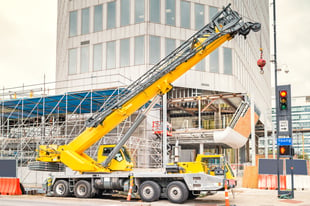The Dotted Line: How to Avoid Skyrocketing Dispute Costs
Written by Joe Bousquin
This feature is a part of “The Dotted Line” series, which takes an in-depth look at the complex legal landscape of the construction industry. To view the entire series, click here.
It’s no secret that construction has gotten more expensive since the pandemic, with material and labor costs ballooning and supply chain issues complicating project deliveries.
But now, a second wave of increases may be hitting the industry, in the form of rising dispute costs.
According to Arcadis, the Amsterdam-based engineering firm, the average value of construction disputes in North America rose 42% last year to hit $42.8 million, up from $30.1 million previously, with the largest single claim ringing in at $2 billion.
That average was by far the highest value Arcadis has seen over the last 13 years of publishing its report, and double the amount from its annual survey results in the 2016-2019 time period, before the pandemic. Indeed, since 2019, the average dispute has increased by 128%.
Call it a holdover from COVID-19. The firm said the rise in dispute costs “illuminates the challenges and changes that society and the industry has experienced since 2020.”
A Confluence of Issues
For lawyers operating on the front lines of construction disputes today, those findings make sense.
“Over the past few years, we've certainly seen a dramatic increase in claim severities, which is how we say it when the amount goes up,” said Michael Vardaro, a former construction worker and current managing partner at construction law firm Zetlin & De Chiara in New York City. “Big construction disputes arise when there’s not one error or one issue, but a few in combination. That’s when you have a problem, and that’s kind of where things hit.”
The timing of the cost increase also computes, as projects that were in motion or got underway at the beginning of the pandemic are now coming to completion, said Stewart Whitehead, an attorney at Winstead in Austin, Texas, who has served as lead counsel in construction dispute trials.
“The projects we’re litigating right now were being built when there were supply chain issues and unprecedented price escalations and labor impacts,” Whitehead said. “I don’t have any lawsuits over a building that started in 2023.”
Those issues have only compounded themselves as costs have increased and financing has gotten tighter, according to Julia Holden Davis, a trial lawyer at Gunster in Jacksonville, Florida,
“People are now in a position of needing to fight for money and to recover things that they might have looked past before,” Holden Davis said. “Unfortunately, for some of those projects, they’re not penciling out.”
Dispute Times Falling
If there is a silver lining to the Arcadis disputes report, it’s this: While the dollar amount of the average dispute has gone up, the average time to resolve them actually went down by a few months. The report also didn’t note as dramatic an increase in the number of disputes, though it has been rising.
Vardaro said that concurs with his experience, as well as the conditions that have been present in the industry over the last few years.
“I won't say that the number of claims has gone up, but I think that that's probably to be expected given that construction really has been firing on all cylinders,” Vardaro said. “Typically, when the construction industry is busy, the number of claims is kind of steady. It doesn't increase until we hit a little bit of a slowdown.”
Causes and Solutions
The top three causes of disputes in the industry last year were:
- Errors and/or omissions in the contract document.
- Owner/Contractor/Subcontractor failing to understand or comply with contractual obligations.
- Poorly drafted or incomplete or unsubstantiated claims.
To avoid the first two, lawyers say teams should take the time upfront to thoroughly understand both the project and the contract.
“You need to spend a little bit more time on the front end of the project,” said Whitehead. “Spend a little bit of extra money on the contracts to account for known issues, and to try to think of things you may not know now based on your experience.”
One example that comes to mind, Whitehead said, is climate change, and how the impacts of extreme weather or resource scarcity could impact projects going forward. That might include provisions for water efficiency minimums in a new build, or laying out schedule allowances that give contractors more time for every day temperatures are above 100 degrees, for example.
Preconstruction Planning Key
Holden Davis said one of her most savvy owner clients dots its i’s and crosses its t’s from the beginning.
“They’re very good at making sure that their project team is educated not just in construction, but also specific to the contract,” Holden Davis said. “They spend a lot of time on the front end reviewing documents, trying to understand what's there, raising concerns early and really following all of the requirements in the contract in terms of correspondence and notice and put a lot of emphasis on that organizationally.”
While doing so may cost more money upfront, it pays dividends down the road. Vardaro said that’s especially true when it comes to preconstruction and making sure all stakeholders are on the same page, an area that owners and contractors shouldn’t skimp on.
Click here to learn how to mange risk in preconstruction.
“It’s really thinking about some of those preconstruction services that a contractor can provide,” Vardaro said. “A lot of times, the budget is kept to a minimum, and the project team can’t necessarily do everything they would like. One of the things that comes out of that budget is those preconstruction services.”
Filing Effective Claims
When a claim or dispute is filed, its success or failure often depends on how well it’s drafted. But Whitehead said in his experience from challenges that arose during COVID, those claims were often incomplete.
“We want to see on the critical path where they think COVID impacted the project,” Whitehead said. “If you can’t show us that, sorry.”
For example, Whitehead said an owner he worked with accepted a schedule variation when a contractor’s entire framing crew got sick for two weeks. But when it was one person here or there, claims were less successful.
Constructability Review
In the end, these lawyers and Arcadis said the most effective way to avoid disputes in the first place is to conduct risk management from the beginning, which might include a review of plans for constructability, as well as vetting teams and subs to make sure they’re qualified to do the job.
“In the construction industry, you always hear about the A team being on a project, and those projects usually turn out well,” Vardaro said. “But when you get the C team on a project, maybe not so much.”
Finally, Holden Davis recommended inserting a provision in contracts to designate what’s known as a “project neutral,” or a qualified expert who doesn’t have a stake in the project to serve as the ultimate decisionmaker when there is a disagreement.
That’s different from many form contracts, which often designate the project’s architect in that role. That could paint an otherwise competent professional into a corner where success depends on them admitting they were wrong.
“You’re setting a decisionmaker who may be a contributor, if you will, to whatever the issues are,” Holden Davis said. “No matter how good that entity is, you put them in a really difficult position.”
The Dotted Line series is brought to you by AIA Contract Documents®, a recognized leader in design and construction contracts. To learn more about their 200+ contracts, and to access free resources, visit their website here. AIA Contract Documents has no influence over Construction Dive's coverage within the articles, and content does not reflect the views or opinions of The American Institute of Architects, AIA Contract Documents or its employees.
This article was written by Joe Bousquin from Construction Dive and was legally licensed through the DiveMarketplace by Industry Dive. Please direct all licensing questions to legal@industrydive.com.

-1.png?width=112&height=112&name=image%20(4)-1.png)















